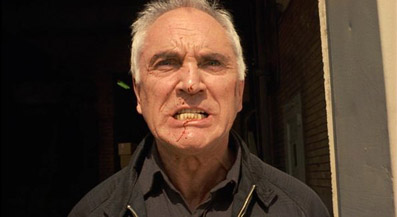|
|
Are You With Us?: The LimeyBy Shalimar SahotaNovember 19, 2009
At 59-years-old during filming, Terence Stamp manages to look exceptionally cool. His character Wilson has nothing to lose and is simply on a one track mind to find out who killed his daughter. Wilson's use of English rhyming slang is a curious addition ("I'll have a butcher's around the house."). Of course not everyone in England uses rhyming slang, but it makes for a welcome annoyance when he has to explain each one for the American audience. His conversation with a Drug Enforcement Administration agent (Bill Duke in an uncredited appearance) is the highlight of the film, which also explains Wilson and Valentine's concluding confrontation. Lem Dobbs' writing is commendable. When Valentine's bodyguard Avery (Newman) asks paltry hitman Stacy (Katt), "How'd you like to kill someone for me," the swift response is hilarious. Apart from what comes out of their mouths, the rest of the actors seem to be following the conventional routine. Peter Fonda flashes guilty smiles, while Barry Newman is intimidating, even to those he's protecting. Also Valentine's business dealings, which lead to Jenny's death, are skimmed and simplified for the audience. The core of what's revealed is that he needed money, and tried to gain some via a drug deal. Edited by Sarah Flack, the unusual style, which flits around with time and memory, is key to how Wilson remembers his daughter. It seems strangely unique at first, but the frequency of it becomes intrusive. It honestly feels more awkward rather then the next best thing filmmakers will be imitating. The film premiered at the Cannes Film Festival in 1999 before being released in October later that year. Released by Artisan (coming off a breakout hit with The Blair Witch Project), they were probably expecting a slow build sleeper with Out of Sight proportions. An extremely limited release with little expansion meant that this never happened. It was released on just 17 screens with a weekend take of $187,000. It managed to expand on as many as 105 screens over the weeks, but with an eventual take of $3.1 million, it just wasn't enough to recoup its $10 million production budget. The Limey doesn't really do anything wrong. It's just a simple story, (a prize for those who can count how many times I've used the word "simple" and its variants), where the only standout feature is its main character. Everything is kept to a minimum, from the running time, the scope of the story, even shot lengths (some scenes have a multitude of cuts). It's not overly exciting, but thankfully it doesn't waste any time trying to be anything else and sticks to the essentials.
[ View other Are You With Us columns ]
[ View other columns by Shalimar Sahota ]
[ Email this column ]
|

|
|
|

|
Friday, November 1, 2024
© 2024 Box Office Prophets, a division of One Of Us, Inc.


